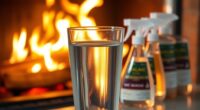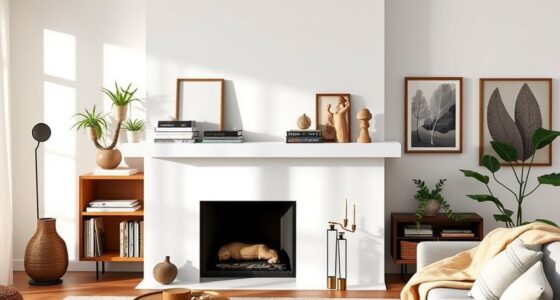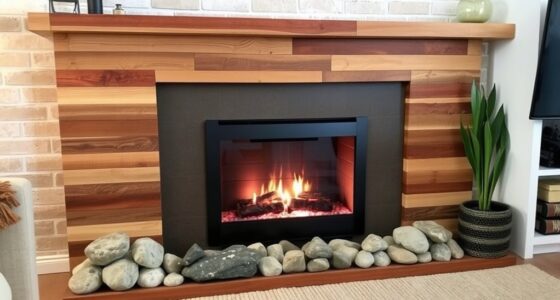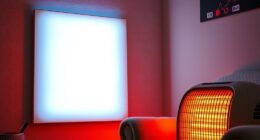To guarantee your mantel and surround ideas meet codes and safety standards, you should understand regional building regulations, choose fire-resistant materials, and measure carefully for proper fit. Avoid common pitfalls like miscalculations or ignoring ventilation needs. Collaborate with professionals early on and use reliable resources to stay current with updates. Following these guidelines helps you create a safe, stylish fireplace that complies with all requirements—continue exploring for more expert tips and detailed steps.
Key Takeaways
- Ensure mantel surrounds meet local fire-resistant materials and clearance requirements for safety and code compliance.
- Properly measure space dimensions and ventilation needs to prevent overheating and adhere to building standards.
- Use certified, fire-resistant materials like rated wood, stone, or metal to meet safety regulations and environmental standards.
- Collaborate with professionals early to navigate complex code requirements and select compliant design and materials.
- Regularly review local building updates and utilize design tools to maintain compliance and safety throughout the project.
Understanding Building Codes for Fireplace Surrounds

Are you aware of the key building codes that govern fireplace surrounds? These codes guarantee your fireplace remains safe, functional, and visually appealing. When considering fireplace aesthetics, understanding local regulations helps you choose materials and designs that meet safety standards while enhancing your mantel design. Building codes specify clearances from combustibles, minimum hearth dimensions, and fire-resistant materials, all vital for safety and code compliance. Ignoring these rules can lead to costly modifications or safety hazards later. Familiarize yourself with the requirements in your area to confidently select or modify your fireplace surround. For example, the presence of fire-resistant materials is often mandated to prevent fire hazards. By doing so, you affirm your project aligns with regulations, providing peace of mind and a beautiful, compliant mantel design that complements your space.
Key Safety Considerations for Mantel Installations
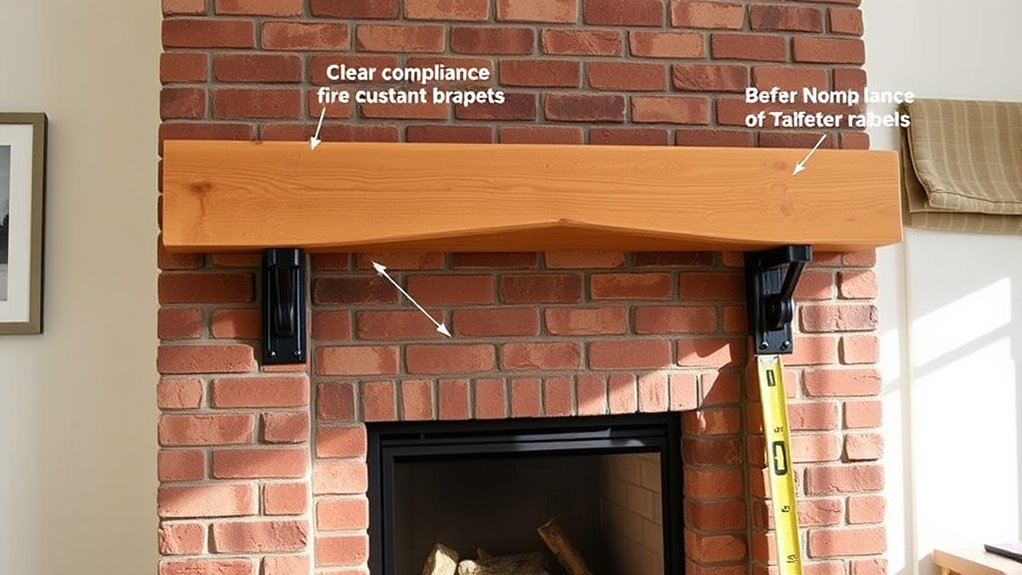
When installing a mantel over a fireplace, safety considerations should be at the forefront of your planning. You need to confirm the mantel is securely anchored to support its weight and prevent hazards. Check that the height and clearance follow building codes to avoid fire risks and maintain proper fireplace aesthetics. A well-designed mantel should complement your fireplace surround ideas without sacrificing safety. Keep combustible materials at a safe distance from heat sources, and verify the wall structure can support the weight of your chosen mantel design ideas. Proper installation not only enhances your space’s visual appeal but also guarantees safety for your household. Always consult local codes and manufacturer instructions to ascertain your mantel installation meets all safety standards. Additionally, understanding the essential oils for fire safety can provide extra precautionary measures in your home.
Material Choices and Compliance Standards

Choosing the right materials for your mantel isn’t just about style; it’s essential to meet safety and compliance standards. You need materials that are fire-resistant and durable, especially around heat sources. When selecting decorative accents, verify they comply with fire safety codes and don’t compromise structural integrity. Consider aesthetic considerations, but never at the expense of safety. Materials like rated fire-resistant wood, stone, or metal can meet both safety standards and your design goals. Check local building codes for specific requirements, and verify that all materials used have proper certifications. Additionally, selecting fire-resistant materials that are also environmentally sustainable can enhance both safety and ecological responsibility. Balancing aesthetic appeal with compliance ensures your mantel is both beautiful and safe, giving you peace of mind without sacrificing style.
Measuring and Planning for Code Adherence

To guarantee your mantel installation complies with building codes, careful measurement and planning are essential. Begin by measuring the available space accurately, considering height, width, and depth, to ensure your design fits within code restrictions. Review ventilation requirements to prevent overheating and ensure safety; this might mean incorporating vents or clearances specified by local regulations. Pay close attention to material specifications, confirming that your chosen materials meet fire safety standards and other code mandates. Document your measurements and plan details thoroughly to facilitate inspections and approvals. Proper planning minimizes surprises during installation and ensures your project aligns with all relevant codes. By focusing on precise measurements and understanding ventilation and material guidelines, you set a solid foundation for a compliant, safe, and attractive mantel installation. Incorporating performance cookies during planning can also help assess how similar projects perform over time and improve future designs.
Common Mistakes and How to Avoid Them

One common mistake is miscalculating measurements, which can lead to a mantel that doesn’t fit or violates code clearances. To avoid this, focus on these key areas:
- Ignoring design aesthetics: Overlooking proportions and style can create a mismatch that distracts from your overall look.
- Overlooking budget considerations: Choosing expensive materials or custom designs without planning can blow your budget and cause compromises.
- Neglecting precise measurements: Failing to double-check dimensions risks installation issues and code violations.
- Not understanding juice detox guidelines: Incorporating information about recommended durations and ingredient choices helps ensure a safe and effective project.
Working With Local Regulations and Permits

Working with local regulations and permits can feel overwhelming, but it’s essential for a smooth project. You need to understand the permit process and guarantee your designs meet all code requirements. Staying informed and organized helps you avoid delays and costly mistakes. For example, understanding viral commercial star trends and how they influence public perception can sometimes be relevant when navigating local media and advertising regulations.
Navigating Permit Processes
Managing permit processes can feel overwhelming, but understanding local regulations and permits is vital for a smooth project. To navigate effectively, start by:
- Researching local building codes related to fireplace aesthetics and design trends to guarantee your plans meet regulations.
- Consulting with the permitting office early to clarify paperwork and approval timelines.
- Preparing thorough documentation that details your fireplace design, materials, and safety measures.
- Incorporating design elements that align with local standards to ensure compliance and avoid future modifications.
Ensuring Code Compliance
To guarantee your fireplace project complies with local regulations, it’s essential to stay informed about current codes and requirements. You need to prioritize fire safety by selecting materials that meet fire-resistant standards and adhere to safety clearances. Ensuring material durability is equally important, as it prevents deterioration over time, reducing fire risks. Check with local building departments for specific regulations regarding mantel heights, surround materials, and venting systems. Document all permits and inspections to demonstrate compliance. Working closely with licensed contractors can help you navigate permits and inspections smoothly. Additionally, understanding cost considerations and potential expenses involved can help you plan your project budget effectively. By understanding and following these requirements, you’ll create a safe, durable fireplace that meets all code standards, giving you peace of mind and a beautiful, compliant installation.
Ensuring Fire Resistance and Heat Protection

To guarantee fire resistance and heat protection, you need to select materials that meet fire-resistant standards and are rated for high temperatures. Proper ventilation techniques help prevent heat buildup and reduce fire risks around your mantel area. Additionally, embracing limits and constraints can inspire innovative solutions for safe fireplace surround designs. By focusing on these key points, you can create a safer, code-compliant fireplace surround.
Fire-Resistant Material Standards
Ensuring fire resistance and heat protection begins with selecting the right materials that meet established standards. You need materials proven to withstand high temperatures and prevent fire spread. First, choose fireproof paint designed to resist ignition and slow down flame propagation. Second, incorporate heat resistant glass in your mantel and surround, which can withstand extreme temperatures without breaking. Third, verify that all materials, including fireproof paint and heat resistant glass, meet local building codes and fire safety regulations. These standards guarantee your installation offers reliable protection. Using compliant materials not only enhances safety but also helps you avoid costly violations. Additionally, selecting materials that conform to Wood Stove Safety Standards ensures your setup maintains proper heat resistance and fire safety. By adhering to these standards, you ensure your fireplace setup is both durable and compliant, giving you peace of mind in your space’s fire resilience.
Proper Ventilation Techniques
Have you considered how proper ventilation plays a fundamental role in fire resistance and heat protection? Adequate ventilation helps prevent heat buildup and reduces fire hazards. Using ventilation fans efficiently moves hot air away from the mantel and surrounding areas, minimizing the risk of ignition. Installing exhaust systems ensures continuous airflow, which helps dissipate heat and maintain safe temperatures. Proper placement of these systems is essential; they should be positioned to maximize airflow without disrupting the fire-resistant materials. Regular maintenance of ventilation fans and exhaust systems keeps them functioning properly, guaranteeing safety standards are met. When ventilation is correctly implemented, it acts as a crucial line of defense, protecting your home from fire risks related to heat accumulation around the mantel and surround areas.
Tips for Staying Up-To-Date With Code Changes

Staying current with code changes can feel overwhelming, but proactive strategies make it manageable. First, subscribe to official updates from local building authorities or industry organizations to get the latest information. Second, regularly review updates and incorporate them into your workflow by updating code documentation promptly. Third, stay vigilant about troubleshooting code violations by referencing new standards and guidelines to prevent recurring issues. These steps ensure you’re informed about changes that impact your work, helping you adapt quickly. Keeping up-to-date minimizes compliance risks and streamlines your processes. Remember, staying proactive saves time and reduces errors, making adherence to codes more straightforward and efficient.
Collaborating With Professionals for Compliance

Working closely with professionals like architects, engineers, and code consultants can substantially simplify the compliance process. They bring valuable expertise to ensure your fireplace aesthetics align with safety standards and building codes. By collaborating early, you gain design inspiration that respects regulations without sacrificing style. These experts can help you navigate complex code requirements, identify potential issues, and suggest solutions that maintain your vision. Their insights make it easier to select materials, placement, and surrounds that meet all standards while enhancing your space’s look. Open communication ensures everyone’s on the same page, reducing delays and costly revisions. Partnering with professionals transforms compliance from a hurdle into an opportunity to elevate your fireplace’s design and functionality.
Practical Tools and Resources for Code Compliance

Steering code compliance can feel overwhelming, but fortunately, there are practical tools and resources that make the process more manageable. These tools help you ensure your fireplace aesthetics and mantel design meet regulations without sacrificing style.
- Local Building Codes and Guidelines: Always start here to understand specific requirements for mantel height, clearance, and materials.
- Design Software and Apps: Use digital tools to visualize fireplace aesthetics and mantel design, ensuring adherence before installation.
- Consultation Resources: Reach out to code officials, industry associations, or online forums for expert advice and updates on code changes.
These resources streamline your project, helping you create beautiful, compliant mantels that blend form with function.
Frequently Asked Questions
How Do I Verify if My Fireplace Surround Meets Local Building Codes?
To verify if your fireplace surround meets local building codes, start by checking your city or county’s building department website for specific safety requirements. Schedule a building inspection if needed, as inspectors will assess fireplace safety and ensure compliance. You can also review relevant codes yourself, but a professional inspection provides peace of mind and guarantees your fireplace surround is up to code, ensuring safety for you and your home.
Are There Specific Brands or Products Recommended for Code-Compliant Mantels?
Did you know that 85% of fireplace-related accidents are due to improper mantel materials? For fire safety, choose brands like Marvin or Hearth & Home that meet UL standards for fireplace safety. These products are designed to comply with local building codes, ensuring your mantel’s safety and durability. Always verify product specifications and consult local regulations before purchasing to keep your home safe and compliant.
What Are the Penalties for Non-Compliance With Fireplace Surround Codes?
If you don’t comply with fireplace surround codes, you risk serious legal consequences, including fines or orders to remove non-compliant installations. Non-compliance increases the fire hazard, potentially leading to property damage or injury. Authorities enforce these rules to protect you and your home. To avoid penalties, make certain your fireplace surround meets all relevant safety standards and codes, and consult professionals if you’re unsure about compliance.
Can I Make Modifications to My Existing Mantel Without Violating Codes?
Yes, you can modify your existing mantel without violating codes, as long as you maintain safety standards and adhere to local regulations. Focus on your fireplace aesthetics and explore various mantel design options that align with code requirements. Before making changes, check with your local building authority to ensure your modifications meet clearance, material, and installation standards, preventing any potential compliance issues and keeping your fireplace safe and stylish.
How Long Does the Permit Process Typically Take for Fireplace Surround Installations?
The permit process for fireplace surround installations usually takes about 2 to 4 weeks, depending on your local jurisdiction. The permit timeline involves submitting your plans, waiting for approval, and scheduling inspections. During the inspection process, a code official verifies your work meets safety standards. To avoid delays, make certain your plans are thorough and compliant with local codes, and schedule inspections promptly once your work is complete.
Conclusion
By understanding and following building codes, you guarantee your fireplace surround is both safe and compliant. For example, imagine installing a mantel that looks great but overheats because you overlooked heat-resistant materials. Staying informed, measuring carefully, and collaborating with professionals help you avoid costly mistakes. With the right tools and knowledge, you can create a beautiful, safe fireplace setup that meets all standards—giving you peace of mind and a warm, stylish space to enjoy.

